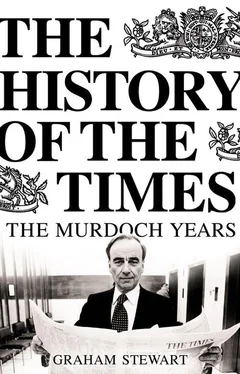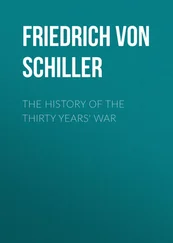Frustrated in his bid to land with the troops, Witherow had got himself transferred to what less intrepid reporters might consider a precarious posting – on board an ammunition ship moored in the ‘bomb alley’ of San Carlos Water. In view of the highly inflammable cargo, he was cheerily assured that if the ship was hit, he wouldn’t need a lifejacket but a parachute. ‘The bombs came within fifty metres. We were feeling a bit nervous,’ he recollected; ‘whenever the planes came in, everybody let loose, bullets, guns, missiles.’ It was a perfect spot to observe the Argentine air force’s finest hour. Night-time offered little relief. Fears that Argentine divers might lay mines necessitated the dropping of depth charges: ‘You would be lying in your bunk at 4 a.m. right next to the waterline,’ Witherow recalled, ‘when suddenly BOOM!’ [377] John Witherow to the author, interview, 9 August 2002.
With the bridgehead on East Falkland secured and the British troops beginning to move inland, Witherow became increasingly frustrated. Having journeyed down with the Navy, he had not had an opportunity to make the now imperative links with the Army that those journalists who had travelled later with the troop ship Canberra had established. Most prominent in this group was Max Hastings of the London Evening Standard . With Hastings and the Army were Michael Nicholson of ITN and the BBC’s Brian Hanrahan who were able to file voice reports (pictures would have to wait) from the beachhead. Eventually, Witherow and the other four journalists on the ammunition ship were helicoptered onto East Falkland. But within hours, they were told they were too inadequately clothed to proceed with the troops and were going to be sent back to the ship. Deciding anything was better than skulking on a floating powder keg, they attempted to hide behind some bales of wool. They were discovered and escorted from the island. Next they were put on board HMS Sir Geraint , a logistical support vessel that promptly sailed back out to sea. For several days Witherow and his companions wondered why their ship appeared to be taking a peculiar course, circling round the aircraft carriers. Eventually they realized the Sir Geraint was trying to draw an Exocet missile attack upon itself so as to save the carriers. Having placed the press corps on, respectively, an ammunition ship and a decoy for air assault, it was clear what the Royal Navy thought of their travelling journalists. The land campaign had been going for two weeks before Witherow was next permitted to step ashore with 5 Brigade.
By then the most famous land battle of the war, Goose Green, had been won. Without air support and with little in the way of artillery, 2 Para had attacked and overcome an entrenched enemy nearly three times their size, taken 1400 prisoners and freed 114 islanders shut up in a guarded community hall. It was an impressive feat and earned a posthumous Victoria Cross for Colonel ‘H’ Jones, the commanding officer who fell with seventeen of his men. But not everyone had played his or her part. With a level of ineptitude far surpassing their usual reticence, the MoD in London had announced the capture of Goose Green eighteen hours before it happened. The BBC’s World Service reported the news that the attack was about to take place. In the meantime, the Argentine troops rearranged their defences to guard against an assault from exactly the direction 2 Para were approaching – supposedly in secrecy. [378] Hudson and Stanier, War and the Media , p. 175.
This scandalous lapse was primarily the MoD’s fault, but it generated further animosity between the troops and the reporters. In Gray’s Inn Road, the fall of Goose Green was not the main story. Instead, Fred Emery decided to lead with the Pope’s arrival in Britain because the first steps of a pontiff on British soil were of greater historical significance. [379] Fred Emery to Charles Douglas-Home, ref. A751/9256/9/2.
The British Army’s objective was now to yomp across East Falkland, eject the Argentines from the defensive positions in the hills to the west and south of Stanley and liberate the capital. Having finally got himself accredited to 5 Brigade, Witherow proceeded to spend some days with the Gurkhas before attaching himself to the Welsh Guards, a regiment he rightly assumed would be in the thick of any fighting. Despite the cold weather, he spent most nights huddled up in barns or sheds or, occasionally, trying to sleep outdoors. The only way he could now get copy to London was to write it down, persuade a helicopter pilot to carry it on his next trip back to HMS Fearless (where all journalists’ copy was being directed) and then have the ship transmit it to the MoD censors in Northwood from where it would, it was hoped, be passed, unedited, onto Gray’s Inn Road. This chain of action only worked if the pilot remembered to pass the copy to someone who knew what to do with it next. Frequently, the copy got mislaid, put aside or discarded at some point along this convoluted process. One of the reports that got lost in transit was a graphic eyewitness account of the horror on board the stricken landing ships Sir Tristram and Sir Galahad from Mick Seamark of the Daily Star . Some felt its loss was convenient. [380] Hudson and Stanier, War and the Media , p. 173.
Witherow was at Bluff Cove when the disaster struck. His dispatch – which did get through – conveyed the essentials that between five hundred and six hundred men from the Royal Marines and the Welsh Guards had been on the ships, awaiting disembarkation when the air attack came. One survivor was quoted as stating, ‘People were screaming, trapped in their rooms. People were in agony. There was mangled wreckage in the corridor.’ [381] The Times , 11 June 1982.
The attack had come on Tuesday 8 June yet such was the MoD’s reticence in releasing details that the death toll had still not been confirmed when The Times went to press for its Saturday 12 June edition – four days after the ships had been hit. Henry Stanhope was left to report the rumours of forty-six deaths and 130 wounded but that ‘the Ministry’s refusal to give casualty figures has also prompted wide speculation in Washington where some sources say British casualties in the Tuesday raids are estimated at 300 dead and a large number wounded’. [382] Ibid., 12 June 1982.
The actual figure was fifty-one fatalities and forty-six injuries.
The MoD’s failure to respond quickly with accurate information was not a cause of media incompetence, as was widely assumed at the time, but of military cunning. The Argentinians believed they had inflicted nine hundred casualties and checked the British advance. Determined to foster this misimpression in their opponents’ minds, the MoD deliberately briefed the press that losses had indeed been very heavy and the assault on Stanley might have to be postponed. Henry Stanhope dutifully reported this misinformation. [383] Ibid., 10 June 1982.
The true death toll was withheld until the assault on Stanley had commenced on time and at full strength. [384] Hastings and Jenkins, The Battle for the Falklands , pp. 320–21.
As Admiral Sir Terence Lewin later put it, ‘The Bluff Cove incident, when we deliberately concealed the casualty figures, was an example of using the press, the media, to further our military operations.’ [385] Quoted in Harris, Gotcha! , p. 118.
Witherow moved up with the Welsh Guards as they advanced for the final push. Passing gingerly through a minefield he observed the battle of Mount Tumbledown from ‘quite a way back’. Comprehensively defeated in the hills around the capital, the Argentine garrison was now preparing to surrender. Reaching the outskirts of Stanley, Witherow noted that the road ahead appeared to be open. He decided to advance on the city, hoping to be the first journalist – indeed the first person with the Task Force – into the islands’ capital. Gallingly, he discovered the omnipresent Max Hastings of the Evening Standard had beaten him to it. By the time Witherow’s report made it into The Times it was as the follow-up to Hastings’s celebrated dispatch describing the moment he liberated the Upland Goose Hotel. Taking advantage of the order to 2 Para to halt just outside the city while negotiations were entered into, Hastings had seen his chance and – exchanging his Army-issue camouflaged jacket for an anorak – wandered into the city. Finding an Argentine colonel on the steps of the administration block, Hastings recorded, ‘I introduced myself to him quite untruthfully as the correspondent of The Times newspaper, the only British newspaper that it seemed possible he would have heard of.’ [386] Hastings and Jenkins, The Battle for the Falklands , p. 349.
Читать дальше












